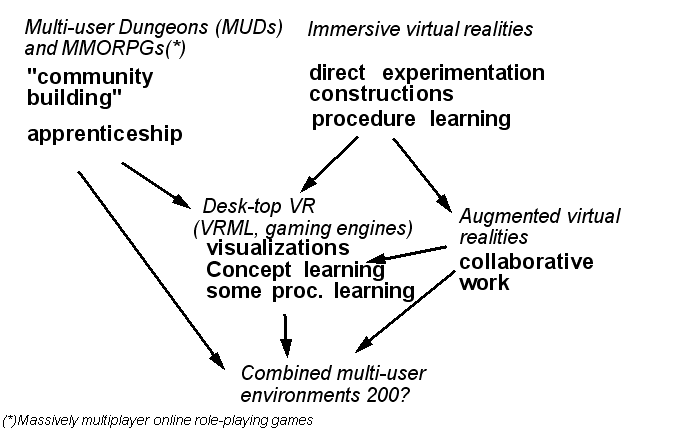Virtual environment: Difference between revisions
m (→Links) |
m (using an external editor) |
||
| Line 1: | Line 1: | ||
{{ | {{incomplete}} | ||
== Definition == | == Definition == | ||
This is a short overview entry with pointers to more specialized articles in this wiki. It also includes some general links and reference. | |||
(Note: Maybe all these articles ought to be reorganized at some point - [[User:Daniel K. Schneider|Daniel K. Schneider]] 13:09, 25 August 2008 (UTC).) | |||
A '''virtual environment''' is a place containing things that can be manipulated and people :). | |||
Types of ''virtual environments'' (internal links you can follow up in random order): | |||
* [[Shared space]]s. Best to start with, since this entry shortly presents a more interesting taxonomy of virtual environments. | |||
* [[text-based virtual reality]], such as [[MOO]]s and [[MUD]]s | * [[text-based virtual reality]], such as [[MOO]]s and [[MUD]]s | ||
* [[mixed reality]] environments | * [[mixed reality]] environments | ||
* Multi-user games with persistant storage features (mostly [[MMORPG]]s) | * Multi-user games with persistant storage features (mostly [[MMORPG]]s) | ||
* Multi-user [[2D interactive environment]]s | * Multi-user [[2D interactive environment]]s | ||
* Multi-user [[3D interactive environments]] with persistant storage capabilities | * Multi-user [[3D interactive environments]] with persistant storage capabilities, a multi-user variant of [[desktop virtual reality]]. | ||
* Immersive 3D environments, i.e. true [[immersive virtual reality]] environments | * Immersive 3D environments, i.e. true [[immersive virtual reality]] environments | ||
* any other form of [[virtual habitat]]s | * any other form of [[virtual habitat]]s | ||
* Collaborative virtual environments (CVEs) - this includes habitats like MUDs, MMORPGs as well as some [[CSCW]] systems. | * Collaborative virtual environments (CVEs) - this includes habitats like MUDs, MMORPGs as well as some [[CSCW]] systems. | ||
* [[ | * [[Virtual reality]] (immersive). | ||
* [[Mixed reality]], i.e. the combination of [[augmented reality]] with [[virtual reality]] or [[desktop virtual reality]]. | |||
See also: | See also related conceptual issues, e.g.: | ||
* [[Community of practice]] | * [[Community of practice]] | ||
* [[Virtual community]] | * [[Virtual community]] | ||
Revision as of 15:09, 25 August 2008
Definition
This is a short overview entry with pointers to more specialized articles in this wiki. It also includes some general links and reference.
(Note: Maybe all these articles ought to be reorganized at some point - Daniel K. Schneider 13:09, 25 August 2008 (UTC).)
A virtual environment is a place containing things that can be manipulated and people :).
Types of virtual environments (internal links you can follow up in random order):
- Shared spaces. Best to start with, since this entry shortly presents a more interesting taxonomy of virtual environments.
- text-based virtual reality, such as MOOs and MUDs
- mixed reality environments
- Multi-user games with persistant storage features (mostly MMORPGs)
- Multi-user 2D interactive environments
- Multi-user 3D interactive environments with persistant storage capabilities, a multi-user variant of desktop virtual reality.
- Immersive 3D environments, i.e. true immersive virtual reality environments
- any other form of virtual habitats
- Collaborative virtual environments (CVEs) - this includes habitats like MUDs, MMORPGs as well as some CSCW systems.
- Virtual reality (immersive).
- Mixed reality, i.e. the combination of augmented reality with virtual reality or desktop virtual reality.
See also related conceptual issues, e.g.:
History
See Raph Koster's excellent Online World Timeline
Typology of virtual environments
There is no real consensus on what constitutes a virtual environment. See also Benford's categorization of shared spaces.
Here is a picture made by DSchneider that shows a variety of such environments and their potential for education:
Links
- Designing Virtual Worlds Bibliography (excellent collection of online texts).
- Terra Nova (good blog to keep in touch with the latest trends in non-educational on-line worlds)
- There are some Wikipedia articles that include useful information, e.g.
- Habitat (video game) (Wikipedia).
- Virtual communities
- Cyberspace (Wikipedia)
- Virtual reality (Wikipedia, aliases from "virtual environment")
- simulated reality
- Association of Virtual Worlds publishes free green (business buide) and blue (consumer) books.
- The blue book has a good long list of virtual environments (including ones for educational use). All kinds of technical environments are considered, most are desktop 3D. As of Aug 2008 its latest edition was: 4th Edition August 2008.
References
- Dieberger, A. (1999) Social connotations of space in the Design for Virtual Communities and Social Navigation. In Munro, A., Höök K. & Benyon D. (Eds), Social Navigation of Information Space, pp. 35-54. Springer: London
